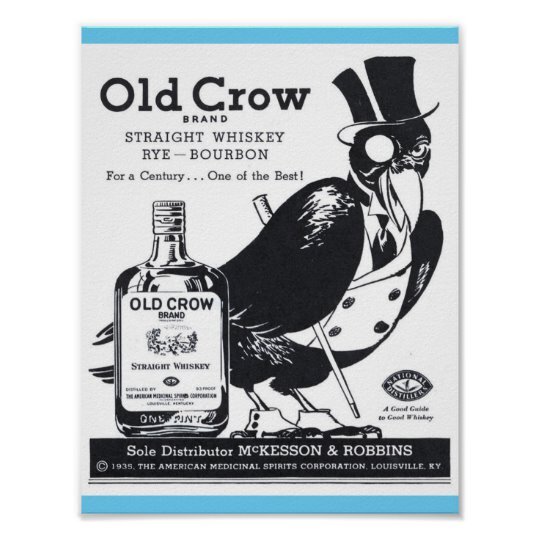Old Crow - From the Top Shelf to the Bottom
In the history of bourbon, there are plenty of stories about the rise and eventual fall of distilleries and brands. Some of those distilleries and brands are resurrected and are now thriving today; some are soon to be. Perhaps no brand has taken a further fall from grace as Old Crow.
In today’s bourbon world, mention the name Old Crow to the average consumer and you probably will get a verbal “Yuck” or a visual turning up of the nose. Today, Old Crow is considered a bottom shelf bourbon that is not tolerable neat and is possibly acceptable in a cocktail. The bottles always sit on the bottom shelf with the likes of Bankers Club and Kentucky Gentlemen and blends like Kessler and Ten High. Unless Beam-Suntory decides to revamp the brand into the premium category again, Old Crow as a bourbon that is highly sought after and considered a top bourbon is a thing of the past.
If you are reading this, you more than likely are familiar with the origin of Old Crow and Dr. James Crow. We will not be rehashing that story. For this piece I wanted to concentrate on the rise and fall of Old Crow bourbon over the past 150+ years. But for readers who are new to this story here are the highlights:
Dr. James Crow was born in Scotland in 1779 and studied medicine and chemistry there.
Around 1823, Dr. Crow moved to Kentucky after going through a bankruptcy. He was drawn by the prospect of creating a viable business in the whiskey distilling industry.
He started his career in the states in 1835 at Grier’s Creek Distillery and is credited with standardizing the sour mash process of distilling spirits. He basically is credited with adding the science portion to the art of distilling.
After 1835, Dr. Crow moved to the Old Pepper Distillery, which is now the home of Woodford Reserve. It was at the distillery that the first batches of what would become Old Crow were distilled.
After the Old Pepper Distillery he moved to the Johnson Distillery which is the same site that would eventually become the famed Old Taylor distillery.
During the period, the bourbon that would later be branded as Old Crow was being produced at the Old Pepper site and it quickly became a highly sought after brand. It is said that bourbon was the favorite among diplomats and politicians such as Henry Clay and Ulysses S. Grant. After Dr. Crow’s death in 1856, his recipe, yeast strains, and process were inherited by William F. Mitchell. Mitchell took that process and recipe to Gaines, Berry and Co. around 1872 at their newly constructed distillery located on the same plot of land as the Old Pepper Distillery.
From around 1878 until prohibition, Old Crow grew in popularity and volume produced and quickly was considered one of the best, if not the best, bourbons being produced. After prohibition, the distillery and Old Crow brand was purchased by National Distillers. In the 30’s,40’s, and 50’s, Old Crow’s popularity rose to rival even Jim Beam as the top selling bourbon in the world. If you have had or will ever have the opportunity to taste Old Crow bourbon from this period you immediately find out how Old Crow could have ever been considered a premium offering and became a top seller.
As the 1960’s wind down, bourbon sales are starting to decline. Bourbon is now considered an old person drink; something your dad would drink. As clear spirits make their rise and bourbon sales start declining, Old Crow distillers made a mistake that would send the once premium bourbon into a death spiral and eventually a permanent home on the bottom shelf.
According to the last master distiller at Crow before National Distillers sold the distillery in 1987 to Beam, there was an error made in the amount of backset returned to the new mash which drastically changed the taste profile. Another popular myth (which I think is true) is that Old Crow somehow lost their yeast strain and were never able to duplicate it. Other accounts state that no one every fully discovered what changed in the process and ingredients but it is commonly agreed upon that in the early 1970’s, Old Crow changed drastically and for the worse.
With the bourbon industry slowing down, National Distillers sold their remaining spirits industry interests, including the Old Crow brand and the distillery. In 1987, Jim Beam Distilling company purchased the distillery and Old Crow label and immediately shut down distilling at that location. The production of the Old Crow brand was moved to Jim Beam.
Today, Old Crow is made of the same mash bill as Jim Beam white label, is younger, and only bottled at 80 proof. There is no advertising of the brand to speak of and its bottles sit on the bottom of liquor shelves begging for eventual consumers. If you have the opportunity to enjoy a dram of dusty Old Crow that was produced during its glory years, please do so. You are drinking a part of history that will not be repeated.
Bourbon history is full of legendary brands like Weller, Van Winkle, Rebel Yell, and Old Granddad that were once considered the gold standard of fine bourbon. All of those brands have weathered closed distilleries and changes in ownership. Some of those brands strive today as the gold standard within the bourbon community (Van Winkle, Weller) while others have managed to find cult followings of enthusiasts who enjoy their offerings as cheap, easy drinkers (OGD, Rebel Yell 10 year). Old Crow has fallen from grace and been cast aside as nothing more than an afterthought, with no resurrection in sight.

